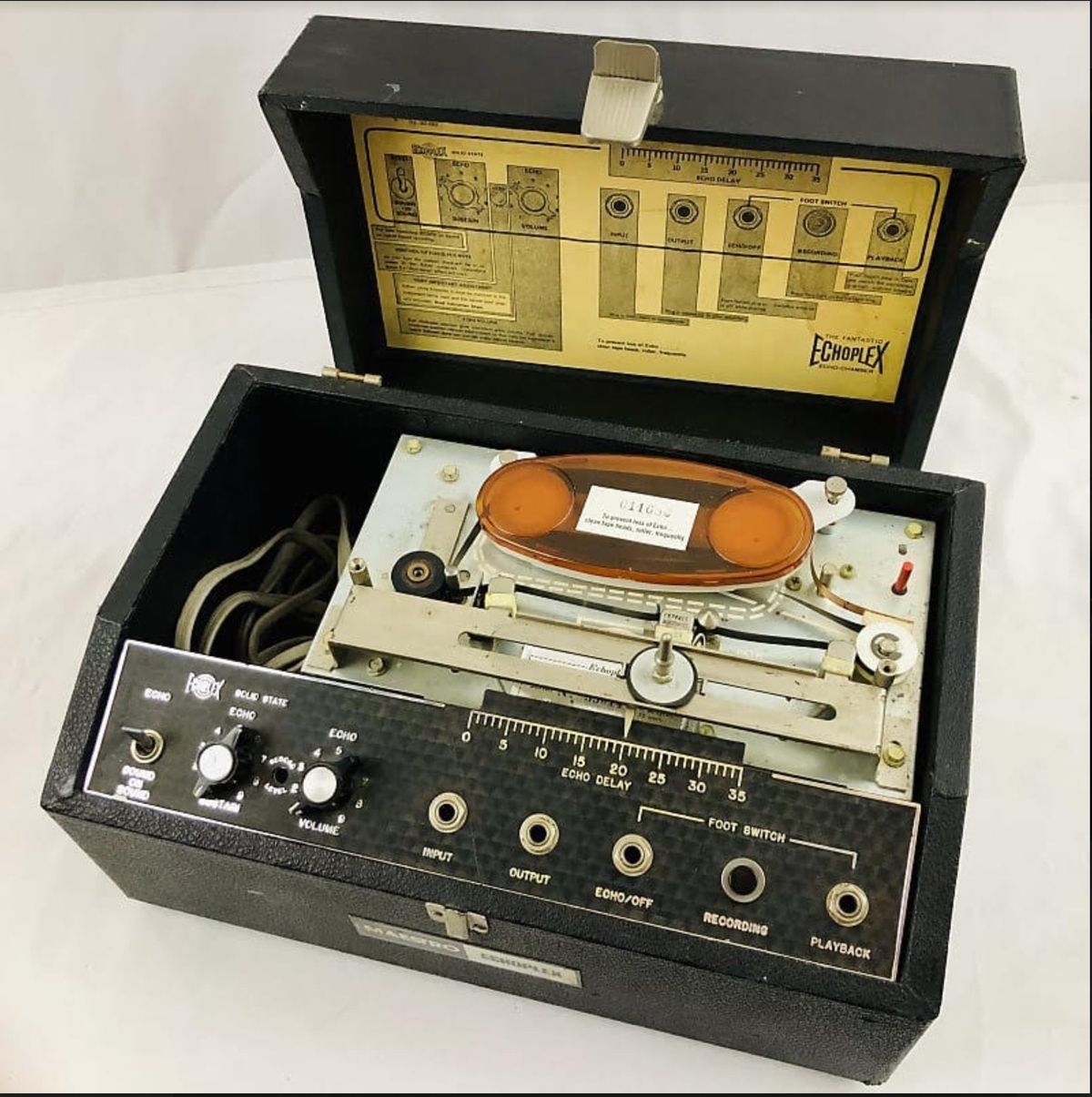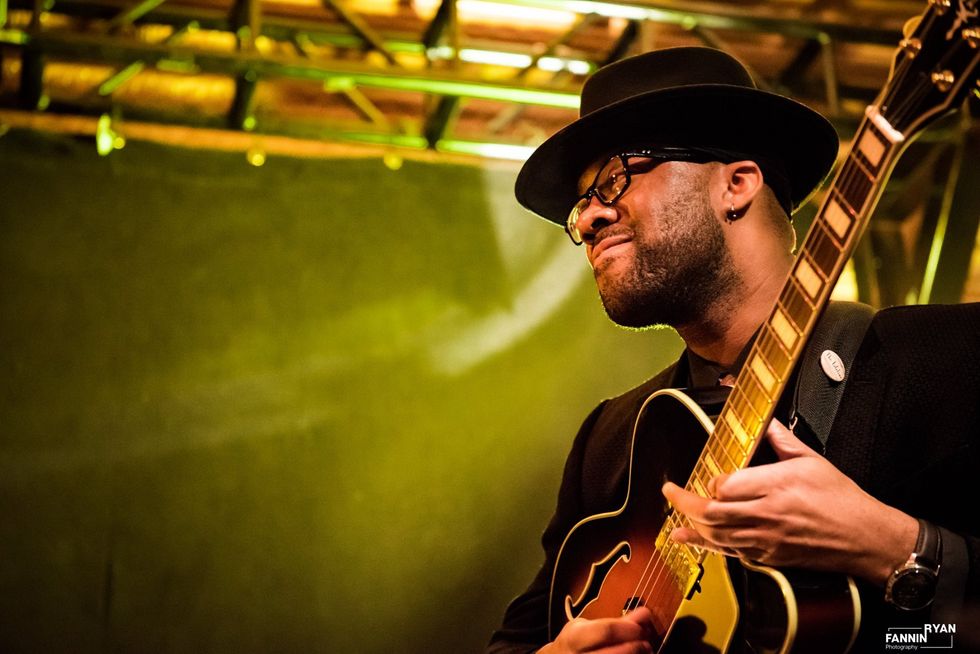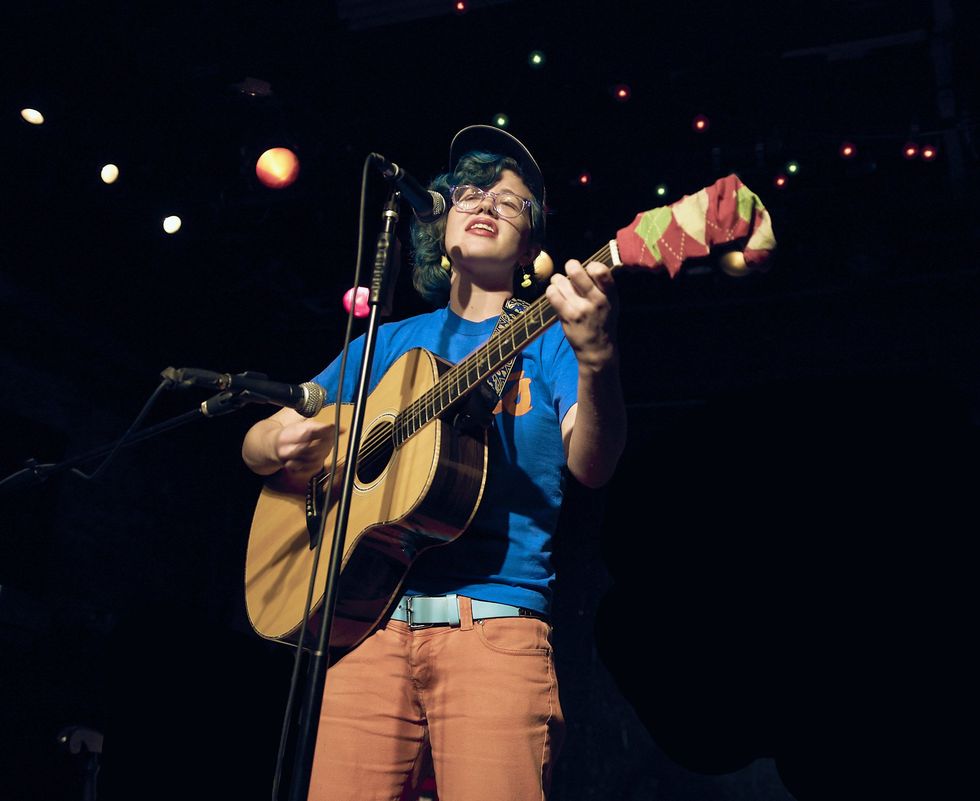
Jesse Dayton uses an EP-3, from the first generation of solid-state Echoplex models, on the road and in the studio.
From Page to Eddie to Gilmour, the comparatively impractical Maestro Echoplex has nonetheless served its masters well. And for some, like our 6-stringing contributor, it still does.
Feast your eyes on the missing link. I give you the coolest contraption to ever run between a guitar and an amplifier: the Maestro Echoplex.
The cool factor for this historic piece of gear is so off the chart that I’m always a bit shocked when players, young or old, are not familiar with this marvelous old-school tape-echo device. But no, I’m not writing this to copy and paste Wikipedia stats on this crown jewel of the guitar-pedal world. (However, if your inner nerdom is anything like mine, it’s worthy of a snoop. All of the Echoplexes from 1959 to the late ’70s sound amazing!) I’m writing to profess to all my fellow guitar gear freaks my undying love for something that was used on so many historical recordings that it’s mind-blowing. And while a big box with an analog tape loop might not be your idea of a great ride-along pal on tour, or even in the studio, truth is, there is nothing else exactly like an authentic Echoplex.
Do you remember the first time you heard that huge swelling repeat sound at the end of “Eruption” by Van Halen? Echoplex. How about the heaviness of Jimmy Page’s guitar on “Moby Dick” by Led Zeppelin? That’s a cranked Echoplex preamp, mis amigos!
The Echoplex design is pretty simple, which is one reason why it’s so iconic. It has actual tape that runs on the top of the unit, records your sound, then plays it back. Remember 8-track tape players? Yeah, kind of like that—except for the recording part. You just crank the slide in the middle—at least on the solid-state EP-3 model that I own—to make the delay effect go fast or slow. It’s not rocket science. But it does also work as a preamp and will enhance the tone of the guitar coming out of your amp like no other unit. Eric Johnson, for example, travels with one in a rack, sans tape, just so he can use the preamp for his classic tone. The Echoplex preamp basically boosts and compresses your signal, fattening it up and providing some EQ trickery that will have guitar players unfamiliar with the device’s charms scratching their heads.
The original Echoplexes come in four flavors: the EP-1, EP-2, EP-3, and EP-4. The EP-1 is the O.G.—the first tape delay ever, with a moving tape head that allows the delay time to be changed. It was made from ’59 to ’62, when the next generation of ’Plex, called the EP-2, not only gave the tape head more mobility but protected the tape itself in a cartridge. The solid-state version was the EP-3, which was used by Van Halen, Page, Tommy Bolin, and Brian May, among others. The EP-4 offered an output buffer to improve impedance-matching with other gear. Today, you can find early generation Echoplexes for anywhere from $1,400 to nearly $2,000, and the EP-3 and EP-4 are in the $600 to $1,500 range, depending on condition.
“I have all kinds of analog delay pedals but none of them compare to the Echoplex.”
There are related devices out there that some vintage-tone-inclined players, like Brian Setzer, prefer. The Roland Space Echo is one, and there’s the Binson Echorec. They’re easier for traveling because the Space Echo has a more efficient tape transport system and the Binson records on a drum rather than a length of tape. David Gilmour from Pink Floyd was a fan of the Echorec. But just remember, it is the original Echoplex sound those models were built to emulate. And both of those artists also used original Echoplex units on a few of their classic recordings.
Sure, you can buy some newfangled digital pedal that tries to recreate the Echoplex, but what fun is there in that? Where’s the potential for tape snarls or the manual cleaning required? After owning several EP-3 Echoplexes and using them in recording studios on countless tracks, touring all over the world with one in cars, vans, RVs, buses, and planes, I can tell you nothing replicates or enhances your tone like an EP-3. And if you do roll out with one, don’t forget Q-tips and a bottle of rubbing alcohol to clean the tape heads when they get dirty. If that doesn’t sound like a good time, then I guess you don't wanna get the sound that fattened up the guitars in power trios like Joe Walsh’s James Gang or on Billy Gibbons’ first five ZZ Top albums.
I have all kinds of analog delay pedals but none of them compare to the Echoplex. Remember, a cool thing about owning vintage gear is not that it’s a piece of handcrafted history, but knowing that Leo Fender or Les Paul himself, or, in this case, Echoplex designer Mike Battle, is never making another one like the one that you own. Don't get overwhelmed or anxious by projecting what could go wrong with it. Get excited about having a piece of gear that can make your guitar sound like almost every classic-rock, blues, and country record ever made.- Imperial Electrical Zeppelin Review ›
- Quick Hit: MXR Echoplex Preamp Mini Review ›
- MXR EP103 Echoplex Delay Review ›
A stripped-down small-bodied acoustic that punches well above its price class.
Midrange-focused voice. Smaller body and scale delivers easy playability. Excellent craftsmanship.
If you love big, boomy jumbos and dreads, you might want to look at a different body style.
$2,450
Iris MS-00
irisguitarcompany.com
As much as I love fawning over expensive vintage and boutique gear—which is a lot—when it comes to spending my money, I look for the highest-end tone at the kind of prices my modest gigs can pay for. With vintage gear, I want to find “player-grade” stuff: the amp that has some long-broken-up band’s logo spray-painted on it, totally devaluing it to collectors, or the guitar with a refin that was done by the last owner’s buddy who paints motorcycles. Sometimes, though, new gear is the only path to what you need. And once you enter the world of boutique, handmade instruments player-grade prices aren’t usually an option.
Since introducing their debut model, the OG, in 2018, Burlington, Vermont’s Iris Guitar Company’s mission has been to carve out a space in a Venn diagram where craftsmanship, tone, and value come together. The team consists of builders who create top-notch, bespoke instruments and started Iris to make instruments at the same level of quality, stripped of most aesthetic accoutrements and customization, at prices working musicians can afford.
One of the newest models in Iris’ expanding line is the MS-00. Inspired by the Gibson L-00, it was created in conjunction with vintage Gibson acoustic expert Mark Stutman of Folkway Music. The MS-00 captures the straightforward, unpretentious Great Depression-era aesthetic and sound of the L-00. And while not cheap, it offers the playing experience of a more expensive instrument.
Think: Sepia
In terms of looks, the simple, down-to-earth MS-00 doesn’t announce itself loudly, but rather invites you in and waits to be noticed. Diminutive fret markers along the MS-00’s Indian rosewood fretboard—which are sized to serve their function to the player but which might escape notice from across the room—complement the simple waterslide-decal Iris logo that adorns the headstock, along with vintage-style open-gear tuners. If there’s one bit of pizzazz, it’s the beveled tortoise pickguard, which is hardly an indulgence. Together, these humble details deliver a warm, sepia-toned aesthetic harmony.
Measuring 19 1/2" long, 14 7/8" at its lower bout and 3 5/8" to 4 3/8" deep, the MS-00 is compact. The handsome, tobacco burst Sitka spruce is supported with Adirondack spruce X-bracing. Finished with a thin, satin nitrocellulose, the MS-00 is comfortable to cradle, too. The back and sides, along with the Honduran mahogany neck, are not treated with pore filler prior to finishing, exposing the grain and giving the guitar a refined but rugged feel. (Spruce doesn’t have deep pores, so the top is smooth.) I can’t help myself from getting poetic and thinking about how this also challenges us to find the beauty within. In a market where deeply figured woods are glamorized, the Iris finish helps us appreciate the beauty in the grain itself. And though the subject is a source of argument, I can’t help but think that the lack of pore filler has a sonic effect as well; the MS-00 practically rings like a bell with every strum.
Warm and Punchy
Like the small-bodied vintage Gibson acoustics that inspired it, the MS-00 sings with a plainspoken midrange-focused voice. It’s warm and inviting, and it feels instantly familiar if you’ve spent time in vintage shops playing those Gibson models.
Gliding along the soft-C neck, which is attached via a more economical bolt-on, mortise and tenon joint, is a breeze. Its 24 3/4" scale length puts everything just a little more within reach than most acoustics, and that kept me busy across all 14 frets. (A 12-fret version can also be ordered as an upcharge.) The mid-focused sound of small-bodied acoustics always feels more natural to me than their bass-heavy counterparts, and this guitar is no exception. The easy-to-fret, midrange-focused formula had my initial playing gravitating toward early jazz chords and lines, both of which the MS-00 feels ideally voiced to handle. That’s not to pigeonhole this guitar at all. I could, and did, have a great time simply strumming away in first position and running through all the Travis-picking tunes I could muster.
The MS-00 feels particularly touch-sensitive, so I took delight in exploring its dynamic range. If you lean toward a softer playing style, it’ll reward you with rich warmth and definition. But if you’re a strummer or just dig in hard, you’ll find plenty of volume without compromising tone or over-compressing. When playing lines with a heavy pick, I was treated to plenty of attack and punch, which I found easy to dial up or back to taste. By applying a heavier hand, especially on the wound strings, I found the growly bite that I find an essential part of a vintage Gibson’s sonic fingerprint.
The Verdict
The MS-00, like every Iris model I’ve played, is a well-executed, simple formula. On a coffee scale, it’s the equivalent of a pour-over made with single-origin beans and taken black. At $2,450, it’s no impulse purchase, but for a U.S.-built, luthier-crafted instrument it’s a serious deal. The MS-00 can go strum for strum with guitars that command much higher prices because it’s designed with only the absolute essentials in mind: sound and playability. If you’re a fan of small-bodied vintage Gibsons, or if you’re simply looking for a dynamic, midrange-focused acoustic that’s fun to play for a little less, the MS-00 is worth your time. It’s going to compete with the best of them.

Bill Wyman's first album in 9 years, Drive My Car is out August 9.
Drive My Car will be available digitally, on CD and gatefold vinyl. Both CD and digital formats will feature two additional bonus tracks.
As a founding member and rhythm architect of The Rolling Stones, Bill became a household name, revered by fans and peers alike. With a career spanning over six decades, Wyman steps back into the spotlight with a fresh collection of songs showcasing his passion and talent. Five tracks, including the album’s title track are self-penned, a testament to Bill’s enduring songwriting talent. “It’s not something I do every day, but sometimes I just see a guitar in the corner of the room, pick it up to play around, and then something clicks into place,” he explains.
Bill Wyman - Drive My Car (Official Lyric Video)
Recorded at Wyman’s home studio, Drive My Car features a tight-knit group of long-time collaborators, including guitarist Terry Taylor and drummer Paul Beavis. “A bass player and a drummer are a team, you’re the rhythm section, the foundation of the whole thing,” Bill emphasizes. The album opens with a unique rendition of Bob Dylan’s 'Thunder On The Mountain,' combining elements from both Dylan's original and Wanda Jackson’s lively cover. “I’ve known Bob since the mid-‘60s," says Bill. "He used to take me and Brian Jones round the Greenwich Village clubs whenever we were in New York. We were very good friends for a while, he was a really nice guy.”
Another highlight is a cover of Taj Mahal’s 'Light Rain.' Bill recounts their long-standing friendship, which began in 1968 when Taj was invited to join The Stones Rock ‘n’ Roll Circus TV special. “He was fascinated that I was a member of the Royal Horticultural Society – we bonded over botany!” he recalls fondly.
Bill Wyman had a busy 2023. The oldest of the Rolling Stones (“They all talk about the war, but none of them remember it like I do!”), Bill mined his memories for vivid anecdotes of his wartime childhood and published them in an engrossing book, Billy In The Wars. At the same time, he was planning for the future, recording the songs for Drive My Car.
Reflecting on the album’s overall sound, Bill cites JJ Cale as a major influence. “I think the biggest influence on the album as a whole is JJ Cale, his laidback groove has always appealed to me. Friends I’ve played it to have said things like ‘it really sounds like you’, and that makes me happy. I’ve never tried to be anyone else - I’m Bill, basically.”
For more information, please visit billwyman.com.
Which guitarists are worthy of an artist-signature model? Rhett and Zach are on the case.
First off, let’s be thankful for this episode of Dipped In Tone. Rhett survived a close brush with a tornado while on the road in Arkansas, and returns to the pod to analyze all things signature guitars with Zach, who continues his dogged campaign to own a ridiculous number of Tube Screamers. (They didn’t plan their near-matching shirts.)
The conversation-starter is the new Jason Isbell “Red Eye,” a $21,999 collector’s version of the 1959 Gibson Les Paul that famously belonged to Ed King of Lynyrd Skynyrd. When King passed away in 2018, the story goes that Isbell wanted the guitar, but couldn’t afford it. Zach and Rhett explain how he accrued the capital to snag the axe, and the details behind the new artist edition.
But who gets signature guitars, anyway? Some iconic players, like John Frusciante—so easily identified with his Strats—still don’t have their own model. Is he being snubbed, or choosing to keep his name off a mass-produced guitar? Maybe some guitarists feel signatures are too corporate—which could also explain why Jack White has, so far, not lent his name to a model. (Though pedals are a different story.) And what about massively popular YouTube guitar stars and influencers—have they earned the right to be in the running for a signature 6-string?
Later, Zach and Rhett dig into the economics of siggys—how much do their namesakes actually earn from the sale of their personal brand?—and debate Slash’s bombshell move from Marshall to Magnatone.
Guest picker Mei Semones joins reader Jin J X and PGstaff in delving into the backgrounds behind their picking styles.
Question: What picking style have you devoted yourself to the most, and why does it work for you?
Guest Picker - Mei Semones

Mei’s latest album, Kabutomushi.
A: The picking style I’ve practiced the most is alternate picking, but the picking style I usually end up using is economy picking. Alternate feels like a dependable way to achieve evenness when practicing scales and arpeggios, but when really playing, it doesn’t make sense to articulate every note in that way, and obviously it’s not always the fastest.
Obsession: My current music-related obsession is my guitar, my PRS McCarty 594 Hollowbody II. I think it will always be an obsession for me. It’s so comfortable and light, has a lovely, warm, dynamic tone, and helps me play faster and cleaner. This guitar feels like my best friend and soulmate.
Reader of the Month - Jin J X

Photo by Ryan Fannin
A: For decades, the Eric Johnson-style “hybrid picking” with a Jazz III for “pianistic” voicings. Great for electric, though not so much acoustic. I’ve been recently learning to use a flatpick, à la Brian Sutton, by driving the pick “into” the string at an angle—which makes me think of Pat Metheny and George Benson, without irony.
Obsession: I’m still focused on understanding the concepts of jazz, neo-classical, and beyond, though I’m also becoming obsessed with George Van Eps’ 7-string playing, flatpicking, hip-hop beats, the Hybrid Guitars Universal 6 guitar, and the secret life of the banjo.
Editorial Director - Ted Drozdowski

A: Decades ago, under the sway of Mississippi blues artists R.L. Burnside, Junior Kimbrough, and Jessie Mae Hemphill, I switched from plectrum to fingerstyle, developing my own non-traditional approach. It’s technically wrong, but watching R.L., in particular, freestyle, I learned there is no such thing as wrong if it works.
Obsession: Busting out of my songwriting patterns. With my band Coyote Motel, and earlier groups, I’ve always encouraged my talented bandmates to play what they want in context, but brought in complete, mapped-out songs. Now, I’m bringing in sketches and we’re jamming and hammering out the arrangements and melodies together. It takes more time, but feels rewarding and fun, and is opening new territory for me.
Managing Editor - Kate Koenig

A: I have always been drawn to fingerpicking on acoustic guitar, starting with classical music and prog-rock pieces (“Mood for a Day” by Steve Howe), and moving on to ’70s baroque-folk styles, basic Travis picking, and songs like “Back to the Old House” by the Smiths. I love the intricacy of those styles, and the challenge of learning to play different rhythms across different fingers at the same time. This is definitely influenced by my classical training on piano, which came before guitar.
Obsession: Writing and producing my fifth and sixth albums. My fifth album, Creature Comforts, was recorded over the past couple months, and features a bunch of songs I wrote in 2022 that I had previously sworn to never record or release. Turns out, upon revisiting, they’re not half bad! While that one’s being wrapped, I’m trying to get music written for my sixth, for which I already have four songs done. And yes, this is a flex. 💪😎


